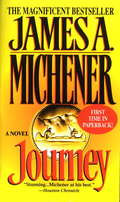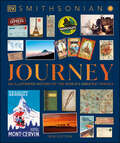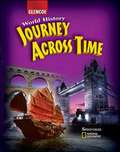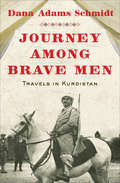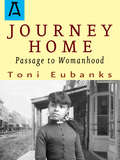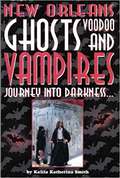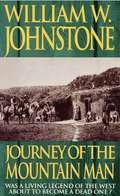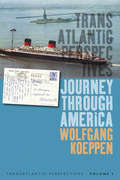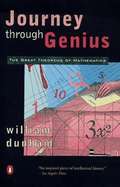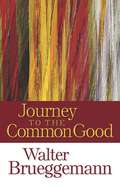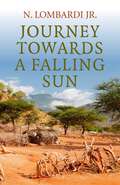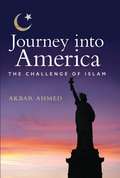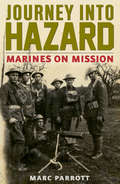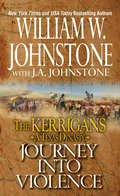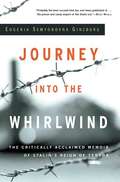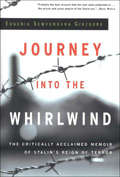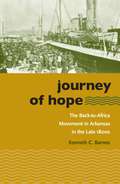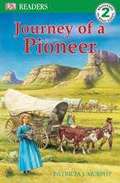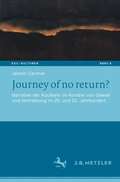- Table View
- List View
Journey
by James A. Michener Steve BerryOne of the premier novelists of the twentieth century, James A. Michener captures a frenzied time when sane men and women risked their very lives in a forbidding Arctic land to win a dazzling and elusive prize: Yukon gold. In 1897, gold fever sweeps the world. The promise of untold riches lures thousands of dreamers from all walks of life on a perilous trek toward fortune, failure--or death. Journey is an immersive account of the adventures of four English aristocrats and their Irish servant as they haul across cruel Canadian terrain toward the Klondike gold fields. Vivid and sweeping, featuring Michener's probing insights into the follies and grandeur of the human spirit, this is the kind of novel only he could write. BONUS: This edition includes an excerpt from James A. Michener's Poland.
Journey (DK Definitive Visual Histories)
by DKFollow the voyages of the Vikings, pursue plundering pirates, trace the Hippie Trail, or set off on a flight to the Moon. A thrilling expedition awaits you on every page.Journeys have arisen from all manner of impulse, from migration and the search for food to pilgrimages, trade, scientific curiosity, or simply the quest for adventure.Packed with stories of human movement and endeavor, Journey lets you experience the excitement and romance of travel, covering everything from quests across the Silk Road and the adventures of Marco Polo to explorations in space and underwater. Discover ancient maps, biographies of conquerors, explorers and travelers, stories of scientific discovery and technological innovation, stunning works of art, and catalogs of travel-related memorabilia.This truly worldwide account is a glorious celebration of human journeys and will make an impressive gift for any lover of travel and history.
Journey Across Time
by Jackson J. Spielvogel The National Geographic SocietyJourney Across Time is a middle school world history program organized chronologically from the first humans and ancient civilizations to the present. It contains a wealth of information.
Journey Among Brave Men
by Dana Adams SchmidtA gripping account of an award-winning journalist&’s journey into the heart of rebel territory during the First Iraqi-Kurdish War. On July 4, 1962, New York Times foreign correspondent Dana Adams Schmidt left his post in Beirut to be voluntarily smuggled into Iraqi Kurdistan. It was the beginning of a nearly two-month journey that would climax in a days-long visit with the leader of the Kurdish rebellion, the most loved and feared man in Kurdistan, Mullah Mustafa Barzani. Accompanied by armed Kurdish guides and a 72-year-old Turkish interpreter, the six-feet-three-inch, seersucker-suit-clad Schmidt traveled, often at night, a secret route by foot, mule, horse and, on two occasions, jeep into the high Kurdish mountains to report on &“the fightingest people in the Middle East&” as no foreign journalist had done before. The physical dangers were acute—his group was strafed more than once by the Iraqi air force. Along the way, Schmidt learned about the history and culture of the Kurds, whose cause Barzani hoped Schmidt could convey to the world. Originally published in 1964 and now back in print with a new foreword by historian Charles Glass, Journey Among Brave Men is an enduring testament to the power of audacious journalism and to the strong will of the Kurds, an embattled people who remain in search of an independent state today. &“One can only marvel at the author&’s indefatigable industry and power of enthusiasm, which makes him one of the most reliable of all daily paper reporters . . . An excellent, fair and patently honest piece of work.&”—The New York Times
Journey Home: Passage to Womanhood
by Toni EubanksJourney Home is the story of Tamara Woodson, who lives in the American West in the 1880s. She is smart and sassy, and has a mind of her own. Like many black families of that era following slavery, her family traveled west and founded their own town. Tamara Woodson is at a turning point in her life. She begins a journey of self-discovery that reveals important connections to her ancestral past. Prompted by her ambitions and experiences, she prepares herself for an uncertain future. At one point, Tamara's fears are expressed in a dream that intertwines a Nigerian Yoruba folktale. She learns to interpret important symbols. At another, Tamara learns about the Apache Indian culture from a girl who is preparing for her own elaborate coming of age ceremony. Exposure to these two cultures helps Tamara validate the values and traditions of others as well as her own. As she matures, Tamara learns to let go of her own fears and to rely on her inner strength. Journey Home is book one in the juvenile historical fiction series, "Passage to Womanhood."
Journey Interrupted: A Family Without a Country in a World at War
by Hildegarde MahoneyIn the midst of World War II, a German-American family finds themselves stranded in Japan in this inspiring tale of an extraordinary family adapting to the hazards of fate, and finding salvation in each other. In the spring of 1941, seven-year-old Hildegarde Ercklentz and her family leave their home in New York City and set off for their native Germany, where her father has been recalled to the headquarters of the Commerz & Privat Bank in Berlin. It was meant to be an epic journey, crossing the United States, the Pacific, and Siberia--but when Hitler invades Russia, a week-long stay in Yokohama, Japan becomes six years of quasi-detention, as Hildegarde and her family are stranded in Japan until the war's end. In this spellbinding memoir, Mahoney recounts her family's moving saga, from their courage in the face of terrible difficulties--including forced relocation, scarce rations, brutal winters in the Japanese Alps--to their joyous reunion with their German relatives in Hamburg, and their eventual return to New York City in 1950. Richly detailed and remarkably vivid, Journey Interrupted is a story unlike any other--the inspiring tale of an extraordinary family adapting to the hazards of fate, and finding salvation in each other.
Journey Into Darkness...Ghosts & Vampires of New Orleans
by Kalila Katherina SmithFrom the Book jacket: Haunted History Tours are regarded by many as being a "must do" for any visitor to New Orleans. This book was created in part, due to simple demand. Many people who have taken our tours would walk away in awe, but also with a fervor for additional knowledge. We welcome your comments, suggestions, and personal experiences from taking our tours. Please write to us at: Haunted History Tours 97 Fontainebleau Drive Ct ~% New Orleans, LA 70125 11~. Or, E-Mail us at info@hauntedhistorytours.com Or, contact us by phone: (504) 861-2727 or Toll Free (888) 6GHOSTS Sidney Smith Owner, Haunted History Tours Kalila Katherina Smith is the founder of the New Orleans Paranormal & Occult Research Society. She and her partner Sidney Smith own and operate Haunted History Tours, Inc. in their native city, New Orleans, Louisiana. A practitioner of eclectic magic, she became interested in the paranormal in her early childhood after numerous personal encounters. Additionally, she is licensed and a certified Advanced Practitioner of Oriental Natural Healing and Integrated Body Mind Therapy. Her study of energy in healing and martial arts enabled her to master an understanding of life force energy and its role in the afterlife and in vampirism. She has been featured on Travel Daily, Places of Mystery, Unsolved Mysteries, In Search of..., Travel Channel's Secrets, MTV's Fear, America's Most Haunted Places, St. Francisville Experiment and Sony's Playstation II, Ghost Hunter. She along with Jeffrey Scott Thomas own RIJAM Entertainment, a full service production company. RIJAM's documentary series. "Worlds of Mystery" along with feature length motion picture productions are available on DVD. Kalila's personal web page: www.kalilasmith.com. LAW Email: kalila@kalilasmith.com.
Journey Of The Mountain Man (Mountain Man #5)
by William W. JohnstoneSmoke Jensen is on the trail to Montana to rescue a relative from a range war in this gritty Western adventure by the USA Today bestselling author.Smoke Jensen couldn't have cared less that a range war had erupted in Montana. But his cousin Fae was stuck right in the middle of a hundred-gun showdown that was about to explode in bullets and blood.When Smoke strapped on his Colts and went to Fae's aid, he knew the deck was stacked against him. Even when he was joined by four old friends, it looked like it was going to be his final stand. But if anyone could buck the odds, it was Smoke Jensen, the last mountain man.
Journey Through America
by Michael Kimmage Wolfgang KoeppenAmerikafahrt by Wolfgang Koeppen is a masterpiece of observation, analysis, and writing, based on his 1958 trip to the United States. A major twentieth-century German writer, Koeppen presents a vivid and fascinating portrait of the US in the late 1950s: its major cities, its literary culture, its troubled race relations, its multi-culturalism and its vast loneliness, a motif drawn, in part, from Kafka's Amerika. A modernist travelogue, the text employs symbol, myth, and image, as if Koeppen sought to answer de Tocqueville's questions in the manner of Joyce and Kafka. Journey through America is also a meditation on America, intended for a German audience and mindful of the destiny of postwar Europe under many Americanizing influences.
Journey Through Genius: The Great Theorems Of Mathematics
by William DunhamLike masterpieces of art, music, and literature, great mathematical theorems are creative milestones, works of genius destined to last forever. Now William Dunham gives them the attention they deserve. Dunham places each theorem within its historical context and explores the very human and often turbulent life of the creator -- from Archimedes, the absentminded theoretician whose absorption in his work often precluded eating or bathing, to Gerolamo Cardano, the sixteenth-century mathematician whose accomplishments flourished despite a bizarre array of misadventures, to the paranoid genius of modern times, Georg Cantor. He also provides step-by-step proofs for the theorems, each easily accessible to readers with no more than a knowledge of high school mathematics. A rare combination of the historical, biographical, and mathematical, Journey Through Genius is a fascinating introduction to a neglected field of human creativity.
Journey To The Common Good
by Walter BrueggemannRespected author and theologian Walter Brueggemann turns his discerning eye to the most critical yet basic needs of a world adapting to a new era, an era defined in large part by America's efforts to rebuild from an age of terror even as it navigates its way through an economic collapse. Yet in spite of these great challenges, Brueggemann calls us to journey together to the common good through neighborliness, covenanting, and reconstruction. Such a concept may seem overwhelming, but writing with his usual theological acumen and social awareness Brueggemann distills this challenge to its most basic issues: where is the church going? What is its role in contemporary society? What lessons does it have to offer a world enmeshed in such turbulent times? The answer is the same answer God gave to the Israelites thousands of years ago: love your neighbor and work for the common good. Brueggemann considers biblical texts as examples of the journey now required of the faithful if they wish to move from isolation and distrust to a practice of neighborliness, as an invitation to a radical choice for life or for death, and as a reliable script for overcoming contemporary problems of loss and restoration in a failed urban economy.
Journey Towards a Falling Sun
by N. LombardiHe's a hard-drinking, philandering American engineer. She's a prim and proper African professor. Their improbable romance begins with a chance encounter on the streets of Nairobi, and soon develops into passionate ardor. Unaware of the consequences that their love affair will bring in the future, they soon find themselves caught up in the tumult of Kenyan politics, trapped in the center of a government scandal, and an incredible odyssey through the wilderness of the northern frontier is their only way out. More than a love story, Journey Towards a Falling Sun tells of a heroic struggle against all odds and a search for cultural identity in a rapidly changing Africa.
Journey for Peace: The Story of Rigoberta Menchu
by Marlene Targ BrillThis biography of Rigoberta Menchu, winner of the 1992 Nobel Peace Prize, discusses her life in a remote Guatemalan village, her dealings with cruel, rich landowners, and her fight for justice.
Journey into America: The Challenge of Islam
by Akbar AhmedFollowing up on his 2007 work, Journey into Islam: The Crisis of Globalization, in which he traveled the Islamic world with a team of researchers to investigate the diversity of Muslim societies abroad, Ahmed (Islamic studies, American U. in Washington, D. C.) here reports on a similar project in which he traveled through Muslim communities across the United States administering questionnaires and conducting interviews in order to explore social patterns and attitudes of American Muslims in the context of the broader history of American racial and religious relations. He begins with an ethnographic discussion of American identity in general before turning to an examination of the ethnography of Islam in America, within which he offers separate discussions of African American Muslims, Muslim immigrants, and white and Latino Muslim converts. He also includes chapters comparing the American experiences of Muslims to that of Jews and Mormons. Annotation ©2010 Book News, Inc., Portland, OR (booknews.com)
Journey into Hazard: Marines on Mission
by Marc ParrottJourney into Hazard: Marines on Mission, 1805-1945, first published in 1962 as Hazard: Marines on Mission, is a recounting of some of the most notable personalities and events in the history of the U.S. Marine Corps: from its humble beginnings in the early 1800s and the fight in the North African Barbary Wars, to the “ideal Marine” Lou Diamond, to the raising of the flag at Iwo Jima and the sad fate of Pima Indian Ira Hayes. While not a book of combat, Journey into Hazard provides insight into a number of nearly forgotten incidents that shaped both the Marines and the United States. Included are 10 pages of maps and illustrations. Author Marc Parrott served in the Marines during World War II.
Journey into Islam: The Crisis of Globalization
by Akbar AhmedGlobalization, the war on terror, and Islamic fundamentalism-followed closely by a rise in Islamophobia-have escalated tensions between Western nations and the Muslim world. Yet internationally renowned Islamic scholar Akbar Ahmed believes that through dialogue and understanding, these cultures can coexist peacefully and respectfully. That hope and belief result in an extraordinary journey. To learn what Muslims think and how they really view America, Ahmed traveled to the three major regions of the Muslim world the Middle East, South Asia, and East Asia. Journey into Islam: The Crisis of Globalization is the riveting story of his search for common ground. His absorbing narrative and personal photos bring the reader on a tour of Islam and its peoples. Ahmed sought to understand the experiences and perceptions of ordinary Muslims. Visiting mosques, madrassahs, and universities, he met with people ranging from Pakastan President Pervez Musharraf to prime ministers, princes, sheikhs, professors, and students. He observed, listened, and asked them questions. For example, who inspires them? What are they reading? How do the Internet and international media impact their lives? How do they view America, the West, and changes in society? Ahmed's anthropological expedition enjoyed extensive access to women and youths, revealing unique information on large yet often misunderstood populations. Lamentably, he found high levels of anti-Americanism and anti-Semitism and a widespread perception that Islam is under attack from the West. But he also brought back reason for hope. He returned from his groundbreaking travels both impressed with the concerned, kind nature of the individuals he encountered and invigorated with the vitality and passion they displayed. Journey into Islam makes a powerful plea for forming friendships across religion, race, and tradition to create lasting peace between Islam and the West.
Journey into Violence: Written in Blood (The Kerrigans A Texas Dynasty #3)
by William W. Johnstone J.A. JohnstoneA Texas frontier family faces deadly conspiracies both at home and on the trail in this Western saga from the New York Times–bestselling authors. The Kerrigans risked everything to stake a claim under a big Texas sky. Now one brave woman is fighting to keep that home, against hard weather, harder luck, and the West&’s most dangerous men. A Ranch Divided . . . Kate Kerrigan has made the hard journey to Dodge City, where a cowboy she hired has been accused of killing a prostitute. Despite his notorious past, Kate still trusts Hank Lowry. And when a hired killer comes after her, she knows she has struck a nerve. Someone has framed Hank for murder in order to cover up an even more sinister crime . . . Meanwhile, Kate&’s son Quinn is manning the home front as it comes under siege. A wagon train full of gravely ill travelers has come to the parched Kerrigan ranch, being led by a man on a secret mission. And when the shooting suddenly starts, one wrong step could be fatal . . . Back in west Texas, the Kerrigan ranch is under siege. A wagon train full of gravely ill travelers has come on to the parched Kerrigan range, being led by a man on a secret mission. With Kate's son Quinn manning the home front, one wrong step could be fatal when the shooting suddenly starts . . .
Journey into the Whirlwind
by Eugenia S. GinzburgBoth witness to and victim of Stalin's reign of terror, a courageous woman tells the story of her harrowing eighteen-year odyssey through Russia's prisons and labor camps.
Journey into the Whirlwind: The Critically Acclaimed Memoir of Stalin's Reign of Terror
by Eugenia Semyonovna GinzburgA woman&’s true account of eighteen years as a Soviet prisoner: &“Not even Alexander Solzhenitsyn&’s One Day in the Life of Ivan Denisovich matches it.&”—The New York Times Book Review In the late 1930s, Eugenia Ginzburg was a wife and mother, a schoolteacher and writer, and a longtime loyal Communist Party member. But like millions of others during Stalin&’s reign of terror, she was arrested—on trumped-up charges of being a Trotskyist terrorist counter-revolutionary—and sentenced to prison. With sharp detail and an indefatigable spirit, Ginzburg recounts her arrest and the eighteen harrowing years she endured in Soviet prisons and labor camps, including two in solitary confinement. Her memoir is &“a compelling personal narrative of survival&” (The New York Times Book Review)—and one of the most important documents of Stalin&’s brutal regime. &“Deeply significant…intensely personal and passionately felt.&”—Time &“Probably the best account that has ever been published of…the prison and camp empire of the Stalin era.&”—Book WorldTranslated by Paul Stevenson and Max Hayward
Journey of Hope
by Debbie KaufmanMarriage Is Not Her Mission Escaping a society wedding, Annabelle Baldwin followed her heart to Liberia to pursue her calling as a missionary. But when an attempted kidnapping lands her under the protection of Stewart Hastings, Anna's journey takes a new turn. The wounded war veteran needs a guide through the jungle. It's a job the underfunded missionary can't refuse, despite the feelings Stewart stirs in her guarded heart. Stewart knows he won't succeed without Anna's expertise. And when danger puts her life at risk, he realizes he cannot live without Anna by his side. But what will it take for a man who has lost his faith to capture the heart of a woman who lives for hers?
Journey of Hope
by Kenneth C. BarnesLiberia was founded by the American Colonization Society (ACS) in the 1820s as an African refuge for free blacks and liberated American slaves. While interest in African migration waned after the Civil War, it roared back in the late nineteenth century with the rise of Jim Crow segregation and disfranchisement throughout the South. The back-to-Africa movement held great new appeal to the South's most marginalized citizens, rural African Americans. Nowhere was this interest in Liberia emigration greater than in Arkansas. More emigrants to Liberia left from Arkansas than any other state in the 1880s and 1890s.In Journey of Hope, Kenneth C. Barnes explains why so many black Arkansas sharecroppers dreamed of Africa and how their dreams of Liberia differed from the reality. This rich narrative also examines the role of poor black farmers in the creation of a black nationalist identity and the importance of the symbolism of an ancestral continent.Based on letters to the ACS and interviews of descendants of the emigrants in war-torn Liberia, this study captures the life of black sharecroppers in the late 1800s and their dreams of escaping to Africa.
Journey of No Return
by Bette M. RossHannah, the daughter of Thomas Robuck, falls in love with Tecumseh--which in some ways becomes a tragedy. The story takes place in the Ohio territory at the time when the Americans are driving the Indians out of the country. A love story and a historical novel, this is the second book in a trilogy.
Journey of a Cotton Blossom
by J. C. VillegasA historical novel containing the interwoven stories of a father and son, each wrestling with his identity at a different time in a world full of hatred. Born amid the bigotry of the Deep South, mixed-race Joseph is a slave in all but name. Separated from his mother at birth, he yearns to run away from his loveless home and find her. It&’s a journey that will take him from plantation to plantation and hardship to hardship, yielding joy, sorrow, and love along the way. Years later, Joseph&’s son, Isaiah, faces his own journey: coming to terms with his homosexuality. But society is still slow to accept change, and Isaiah fears rejection from even those closest to his heart. From 1940s Mississippi to the civil rights era of the &’60s and the push for LGBT equality, the story follows three generations of a family fighting for liberation. J. C. Villegas paints an eye-opening story that will inspire readers to open their hearts to love. Though her characters face different types of discrimination, they all draw strength from love and from their faith in God. Can Joseph find the mother he has never met? Can Isaiah survive injustice and adversity? And can they each learn to love themselves in the face of a world that challenges their right to exist?&“This Southern tale is filled with charm and is a beautiful journey . . . The reader constantly feels a connection to the main characters, who are fighting not only for their lives but, just as importantly, their dignity.&” —Robin McGhee, co-founder and former co-director of GetEQUAL&“A riveting tale of man&’s struggle with identity and survival.&” —PopSugar
Journey of a Pioneer (DK Readers Level 2 Series)
by Patricia J. MurphyAn epic journey with this historic book about the lives of the pioneers. They'll follow Olivia and her family as they travel along the Oregon Trail. Discover what it was like to live in a wagon and sleep under the stars. Learn what the pioneers ate and how they found food.
Journey of no return?: Narrative der Rückkehr im Kontext von Gewalt und Vertreibung im 20. und 21. Jahrhundert (Exil-Kulturen #6)
by Jasmin CentnerDiese literaturwissenschaftliche Studie beschäftigt sich mit Rückkehrerzählungen, denen eine gewaltvolle Vertreibung vorausliegt. Erfahrungen der erzwungenen Entortung und der anschließenden Rückkehr prägen nicht nur die Handlung von Texten, sondern wirken sich auch auf die Ästhetik der Narrationen aus. Die acht untersuchten Erzähltexte (u.a. von Anna Seghers, Abbas Khider, Peter Weiss, Primo Levi, Herta Müller und Doron Rabinovici) befragen (Un-)Möglichkeiten der Rückkehr aus unterschiedlichen Perspektiven. Texte, die vor dem Hintergrund der nationalsozialistischen Vertreibungspolitik entstanden sind, werden mit aktuellen Erzählungen in Verbindung gesetzt. In vier thematischen Sektionen (u.a. Rückkehr aus dem Exil, aus dem Lager sowie nach Palästina/Israel) wird gezeigt, dass die Rückkehr in unterschiedlichen Kontexten ähnliche Erzählmuster hervorbringt sowie Vorstellungen von Heimat und Ursprünglichkeit problematisiert
